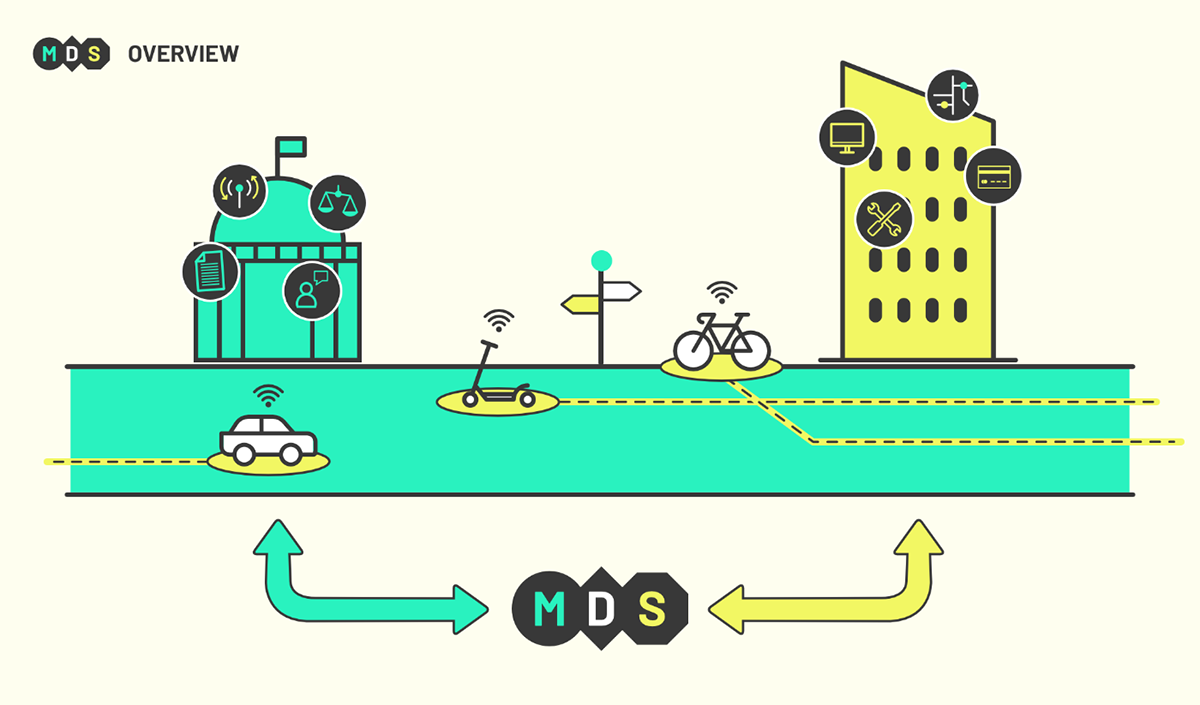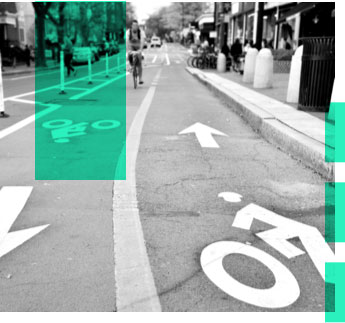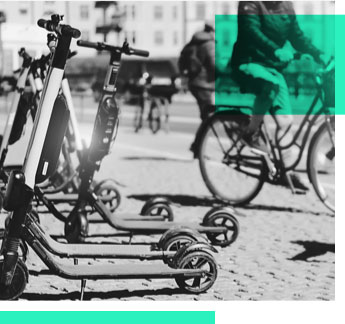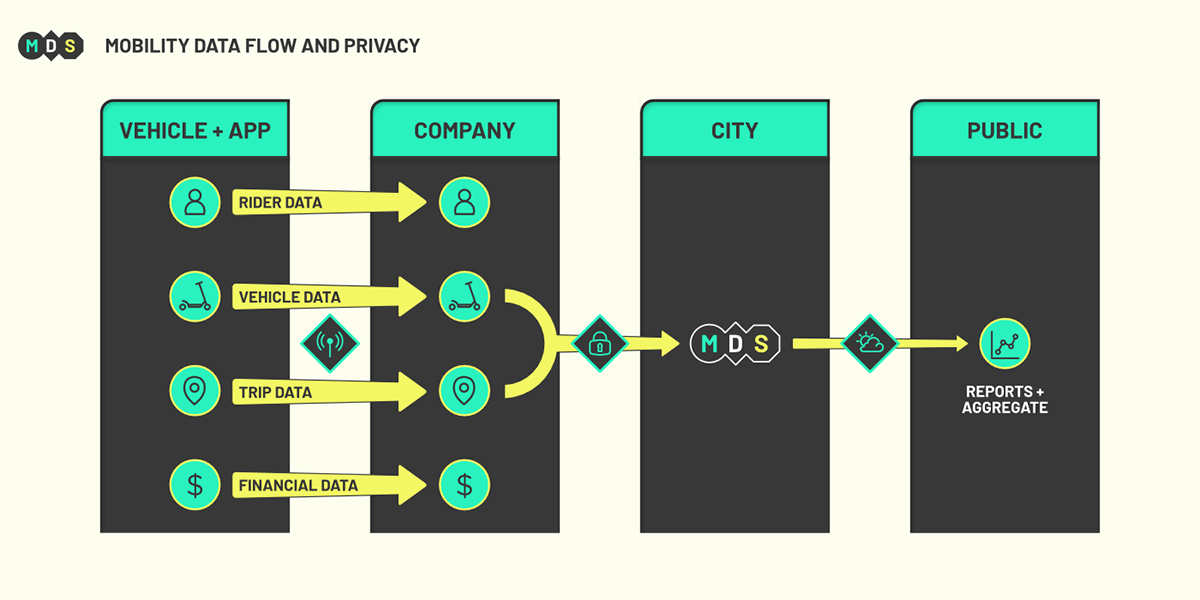About MDS
How it Works • Benefits of MDS • Privacy & Data • Code Releases • Future of MDS

MDS—“Mobility Data Specification”—is a digital tool that helps cities to better manage transportation in the public right of way. MDS standardizes communication and data-sharing between cities and private mobility providers, such as e-scooter and bike share companies. This allows cities to share and validate policy digitally, enabling vehicle management and better outcomes for residents. Plus, it provides mobility service providers with a framework they can re-use in new markets, allowing for seamless collaboration that saves time and money.

MDS—“Mobility Data Specification”—is a digital tool that helps cities to better manage transportation in the public right of way. MDS standardizes communication and data-sharing between cities and private mobility providers, such as e-scooter and bike-share companies. This allows cities to share and validate policy digitally, enabling vehicle management and better outcomes for residents. Plus, it provides mobility service providers with a framework they can re-use in new markets, allowing for seamless collaboration that saves time and money.

OUR VISION FOR MDS
The way we move around our cities is changing quickly. With dockless e-scooters, bikeshares, and ride-hailing services already well established, and new technologies like autonomous vehicles just over the horizon, cities need to be prepared to digitally manage streets, sidewalks, and other public spaces that are more complex and dynamic than ever before.
MDS is designed to enable cities to manage any shared mobility option in the public right of way. That means giving cities the data they need to understand current and historic use patterns and the tools they need to improve the safety, equity, and quality of the mobility services on their streets. MDS is a free, open-source, digital-first platform, so all cities can manage mobility in the ways that work best for them.

HOW MDS WORKS
At its core, MDS is a set of APIs (Application Programming Interfaces) which are protocols that allow data to flow securely between cities and providers. The three primary APIs allow cities and providers to communicate in different ways:
PROVIDER
Provider allows private mobility companies to report data to cities on the number, location, status, and ride history of devices in use.
POLICY
Policy allows cities to set rules for how and where different vehicles can operate, how many can operate, and other high-level policy initiatives.
AGENCY
Agency allows real-time updates and collaboration between city officials and providers when complex city transportation problems demand dynamic solutions.

CITIES
Manages the street and right of way. Responsible for policy, equity, resident feedback and issues, and MDS Agency.
MDS
The digital infrastructure that lets cities and companies share information and manage devices together.
COMPANIES
Manages devices. Responsible for maintenance and repairs, billing, remote monitoring, and MDS Provider.
BENEFITS OF MDS
How MDS benefits cities

MDS gives cities insight into how their public realm is being navigated, and the tools to improve that experience for all.
- Real-time and historic data allows better planning and program management
- Digital management greatly reduces operating costs and staff time spent monitoring mobility programs and service providers
- Allows real-time policy changes to be made to adapt to planned events and emergencies
- Supports policies that allow dynamic pricing, equitable access, and safety initiatives
How MDS benefits PROVIDERS

Establishing mutual trust and a frictionless working relationship between mobility providers and city officials is key to a sustainable future for mobility providers. MDS helps make that possible.
- Streamlines communication between cities and mobility providers, making it easier to collaboratively solve problems with data or assets
- Provides a single reporting standard, eliminating the need for redundant data formatting and processing
- Helps providers scale by offering a platform and best practices that providers can offer to new city markets
CASE STUDIES
When cities and providers work together, they can accomplish great things. Here are some of our favorite MDS success stories.
Fees
Calculating daily permit fees for each device in service is a tricky task, and it can have a big impact on equitable distribution of mobility assets. Here’s how some cities are tackling the challenge.
Dynamic Events
Whether they’re handling an emergency or just a planned road closure, cities are using MDS to make real-time changes in a constantly changing environment. Here’s how.
Safety
When a city is adapting to new modes of transportation, safety is a critical priority. Learn more about how cities use MDS to investigate accidents and set policy to prevent them.
Equity
Demanding fair distribution of new mobility assets is just the start. See how cities are using MDS to create equitable transportation options for all.
Planning
MDS data help cities to plan more efficient use of every part of the public realm. Here’s how cities are deciding where to place new bike/scooter lanes, how to manage curb use and right of way, and much more.
PRIVACY & DATA BEST PRACTICES
MDS data is generated by vehicles, not riders. It includes information about the status of vehicles, their location, and where they are going. It does not contain any personal information about users—which is the type of information that privacy laws and practices have traditionally focused on protecting. Data describing the status of vehicles passes from the company operating the service to the city regulating that service, never directly from riders. While mobility operators collect the name, contact information, payment information, and trip history of each rider in order to provide service, MDS does not contain this or any specific information about who uses a shared vehicle.

Cellular broadcast of detailed data to company
Subset of vehicle and trip data securely transferred
Open data and sunshine laws through the internet
That does not mean that there is no risk associated with MDS data. Like a lot of the information that cities routinely handle, data collected about mobility is sensitive. A big part of our mission is to equip cities with the support and resources they need to keep that information safe and secure. Each city’s data needs and privacy policies will be different, but every city needs to be able to:
- Identify use cases for MDS data
- Assess readiness to handle data securely
- Provide for public feedback and transparency
- Manage and mitigate risk
To help cities put the right policies in place, we’ve created a comprehensive MDS Privacy Guide (PDF) and best-practices document as well as a guide to Using MDS Under GDPR.
MDS CODE RELEASES
MDS is updated regularly with new features requested by the community of cities, providers, and other users of MDS. We use Github to manage all of our release work in the open and much of the discussion and proposals. The Mobility Data Specification repository is where this community development happens.
CURRENT RELEASE
UPCOMING RELEASE
TBD (2.1 or 3.0)
FUTURE OF MDS
Today, MDS helps cities manage the use of microbility solutions in the public right of way, like e-scooters and bikes shares. But, we believe MDS can give cities the data and tools they need to digitally manage many more aspects of the public realm.

We see a future in which cities are able to respond to ever-changing demands on the public right of way with greater speed and precision. That means preparing cities to handle everything from increasing urban freight traffic to fleets of autonomous vehicles. It also means giving cities the ability to digitally manage everything from the use of valuable curb space to dynamic parking pricing.
For a deep dive into our understanding of the current mobility landscape, the forces that are shaping its future, and the role MDS has to play in that future, please see the OMF’s Architectural Landscape.
